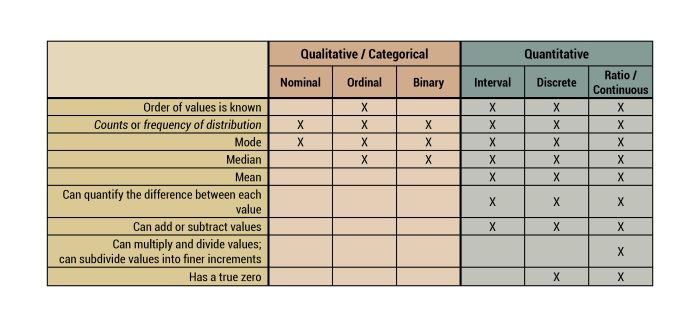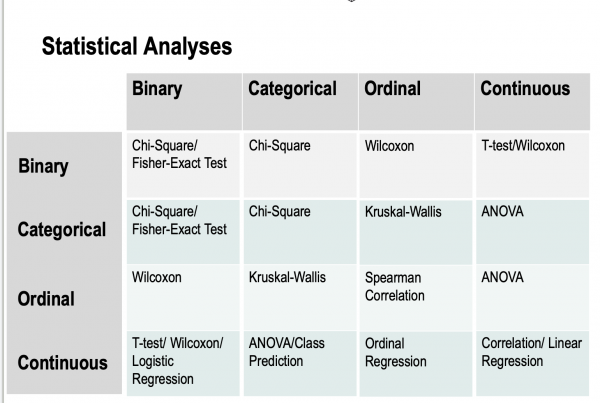Data formats
Note: The German version of this entry can be found here: Data formats (German).
In short: This entry introduces different data formats.
Contents
Data formats in statistics
The format of your data influences everything else you do further down the road. To paraphrase a proverb, data is in a format, and the format is the data. Therefore, it is essential to know which different data formats exist, and how these may be beneficial, and where you may encounter pitfalls. For more information on different means of measurement, please refer to the 'To Rule And To Measure' entry.
The most important difference is between quantitative data and qualitative data. Quantitative data can consist of continuous, discrete or interval data, while qualitative data can be factorial -meaning in truly different categories- nominal or ordinal, with the latter two providing a link to quantitative data. However, within different areas of science, the nomenclature for data formats widely differs, and to be honest, it is a mess. Here, we try to be consistent, yet please be aware that these names are not consistent across science.
Examples of different data formats
Imagine you want to track your diet. Many people do this today, there are diet books and advice everywhere, much information has become available. Now you want to start and become more familiar with what you eat. How would you start? Counting calories? Differentiating between carbs, fats and greens? Maybe you just count every time you ate a pizza? Or ice cream? Or too much? There are many ways to measure your diet. And these measurements can be in different data formats.
Most data formats can be transformed into other data formats, which is often confusing for many people. For instance nominal data can be counted repeatedly, you may for instance count the quite diverse and different cups of coffee you drink every day, such as a Flat-white, an American, and two Espressi. The numbers of cups would then add up to cups of coffee, which would represent discrete data. A different example would be a person's height, which could be represented as continuous data in meters. While this can be represented in numbers, it could also be represented in categories "short" and "tall".
Quantitative data
Quantitative data (numeric) is data that is expressed in numbers which can be used in a numerical sense, i.e. the numbers can be used to do calculations. There are three types of quantitative data: Continuous, discrete and interval data.
Continuous data
Continuous data is numerical data that cannot be counted because it exists on a finite or infinite number line. We are all familiar with continuous numbers. Much of our society is ruled by these numbers, and thus much of data analysed in statistics is represented by continuous numbers. Since much of modern measurement is automated within a given predefined system, we often do not have to worry too much how data looks like. Take for instance weight or size. Within Central Europe, this is clearly measured in grams or kilograms, and in centimeters or meters, respectively. However, if you move to the US, it becomes a whole different story, because of the metric system, or the lack thereof. Suddenly you are some feet tall, and you may weigh some "stones". Many diverse measurement systems exist, and one has to be aware of how these were measured. Hence these systems are constructs, and these constructs build on continuous numbers. Continuous numbers are widely used to express data, but we have to be aware that this then still represents normative information.
Continuous data has a true zero. A true zero is defined as a total absence of something that can be represented in numbers. Although a weight of 0 kg or a length of 0 m is abstract, the values represent the absence of weight and length, respectively.
Examples of continuous data:
- the number Pi: 3,14159265359...
- typical weight of a naked mole-rat: 30 grams
- the height of the Empire State Building: 443,2m
Discrete data
Discrete data is numeric data that can be counted because it only exists as natural numbers (1, 2, 3, 4...). Examples of this are students in a lecture, where the use of fraction numbers is not helpful. Of course, you can think of an halved apple, but usually, if we count apples or birds or students, we consider them as complete units and stick to natural numbers. Discrete data is often also referred to as 'abundance' or 'counting' data, and within the R language it is called "integer".
Discrete data also has a true zero. Take again the number of students in a statistics lecture. Although the lecture is good, for example because it includes songs of Sesame Street, there might be no students in the lecture. 0 students in a lecture – there you got your true zero.
Interval data
Interval data consists of measured or counted values, but it does not have a true zero. Also, the difference between two data points is equal no matter where on the scale you look. The best example is temperature if measured in °C. The difference between 30°C and 40°C is equal to the difference between 100°C and 110°C. However, there is no true zero to the Celsius scale: 0°C does not mean that there is no temperature. Rather, 0°C represents a specific value on the temperature scale. Therefore, you can subtract and add up temperature data, but you cannot meaningfully multiply or divide with it. In addition, the lack of a real zero means that 40°C is not twice as much energy as 20°C, although the value is twice as high.
Qualitative data
Qualitative (categorical) data in a statistical sense is data that can be stored in labeled categories which are independent from each other. Such categories are typically constructed, and thus contain information that is deeply normative or designed. An example would be hair color, which can be in human perceptions of colours, yet is often also described with different names when it comes to professional hair products. Within statistics, categories are often designed so that within a scientific experiment, categories are constructed in a sense that allows for a meaningful testing of the hypothesis, and meaningful is then in the eye of the beholder. Different levels of fertiliser would be such an example, and the categories would often be built around previous knowledge or pre-tests. Categories are thus of particular importance when it comes to the reduction of the complexity of the world, as it would not be possible to test all sorts of different levels of fertiliser in an experiment. Instead, you might go with "little", "moderate", "much" and "very much" fertiliser. Nevertheless, this demands a clear recognition that and how categories are constructed, and deeply normative.
There are two types of qualitative data: ordinal data and nominal data - and then there is binary data, which is basically also nominal.
Ordinal data
Ordinal data is categorical data that can be ranked, but not calculated with, even if it is represented in numbers. Remember your school grades? A "1" is the best grade in the German grading system, but is it twice as good than a "2"? Hardly. Such grades are ordinal numbers. These are a system of numbers that are ranked in some sense, but the numbers per se do not necessarily reflect a numeric system. In other words, they are highly normative and contested. A "2" might be a good grade for some, and a disaster for others. Ordinal formats are often clearly defined scales that allow people to grade, evaluate or rank certain information. One of the most prominent examples is the Likert scale that is often used in Psychology. In this case, the scaling is often not reflected in numbers at all, but in levels such as "Strongly Agree" or "Rather Disagree". Such constructed scales may make a true statistician very unhappy, since these scales are hard to analyse, yet there is hardly any alternative since it also does not make any sense to ask: "How happy are you on a scale from 1 to 100?". Therefore, ordinal scales are often relevant in order to create a scaling system that allows for wide comparability or even becomes a norm, such as school grades. My advise would be to use ordinal scales when this is common practice in this branch of science. Read other studies in the field, and then decide. These are highly constructed scales, hence there needs to be clear reasoning on why you want to use them.
Nominal data
Whenever you have categorical data that cannot be ranked, it is called nominal data. An example would be different ethnicities, countries of birth, or different types of gender. This already highlights that we are here confronted by often completely different worldviews, thus nominal data represents a stark case of a normative view of the world. Gender is a prominent example, since some people still define gender by a biological stereotype (Female/Male) and thus binary (see below), which according to my worldview is clearly wrong, and I see gender as nominal with more than two categories. Nominal data formats hence demand an even clearer reflection than ordinal data, where at least you may say that a certain school grade is higher than another one. This is not the case for nominal data. Therefore, one has to be extra careful about the implications that a specific constructed scale may imply.
Binary data
Binary data is the most reduced data format, which basically consists of two levels: 1 and 0. It is, strictly speaking, nominal data, but nominal data that only exists in two versions which can be translated into 1 and 0: On / Off, Yes / No. In computer science binary data is used directly as simple 0 and 1, but the great breakthrough of that dataset was early on in the insurance business as well as in medicine, where 'dead' or 'alive' are often the most fundamental questions. Binary information is clearly simplistic, but quite often this matches with a certain view of reality. Take the example of being able to play an instrument. If somebody asks you whether you can play the piano, you will probably say yes or no. You may most likely not qualify your answer by saying "I play better than a monkey, but worse than Horowitz". Some modest folks may say "I can play a bit", or "I am not very good", or "I used to be better", but very often people answer yes or no. Hence binary data allows for a simple view of reality, and this may often match with the world how we perceive it. But be aware: Other people may have a less simple view.
Choosing the right data format
You may wonder now how to choose the right data format for your data gathering. The answer to that is quite simple. Any data format should be as simple as possible, and as complex as necessary. Follow Occam's razor, and you will be fine. Of course this sounds appealing, but how to know what is too simple, and what is too complex? Here, I suggest you build on the available literature. Read other publications that examined a certain phenomenon before, these papers may guide you in choosing the right scale.
This table gives you some more information on different data formats - maybe it can help you design your study?
Which simple test works for which data format?
The following table which we compiled shows which statistical tests are useful depending on the data you have. To learn more about these tests, please refer to the entries on Simple Statistical Tests, Regression Analysis, Correlations and ANOVA. Note: for combinations that lead to different methods (e.g. ordinal x continuous), please refer to all mentioned approaches.
A word on indices
In economics and finance, an index is a statistical measure of change in a representative group of individual data points. A good example of the application of an index that most people know is the GDP, the gross domestic product of a country. Although it has largely been criticised for being too generalised and not offering enough nuance to understand the complexity of the single country, many social, economical and other indicators are correlated with the GDP.
In ecology, a prominent example for an index is the so-called Shannon Wiener index, which represents abundance corrected diversity measures. A prominent example from economy again is the Dow Jones index while the human development index tries to integrate information about life expectancy, education and income in order to get a general understanding about several components that characterise countries. The GINI coefficient tries to measure inequality, a surely daring endeavour, but nevertheless quite important. In psychology the intelligence quotient (IQ), which is of course heavily criticised, is a known example of reducing many complex tests into one overall number. Indices and quotients are hence constructs that are often based on many variables and try to reduce the complexity of these diverse indicators into one set of numbers.
Further Information
Videos
Intelligence Quotient: Answering the question if the IQ really measures how smart you are
Different data formats: An overview
Binary data: How our computer works
The Shannon Wiener index: An example from ecology
The Dow Jones Index: An example from economy
The Intelligence Quotient: A critical reflection
Descriptive Statistics: A whole video series about descriptive statistics from the Khan academy
Standard Deviation: A brief explanation
Mode, Median, Mean, Range & Standard Deviation: A good summary
Back-of-envelope office space conundrum: A real life example
Articles
Measurement: Reflecting upon different measurement systems across the globe
IQ: An explanation
Nominal vs. ordinal data: A comparison
Likert scale: The most popular rating scale
Ordinal data: Limitations
Nominal data: An explanation
Binary data: An explanation
GDP: A detailed article
The Human Development Index: An alternative to the GDP
The GINI index: A measure of inequality
Descriptive Statistics: An introduction
Descriptive Statistics: A detailed summary
Back of the Envelope Calculation: An explanation
Estimates of Next Quarter’s Unemployment Rate: An Example For Back of the Envelope Statistics
The author of this entry is Henrik von Wehrden.






